The Sami and World War II
World War II was a pivotal point in world history. It seems as though, during the years of war, there was no nation or peoples left untouched by the repercussions of war. Take for instance the Sami. Here are a people whose culture has been known as a peaceful culture for hundreds of years. Yet, even they were involved in a war they did not start and possibly did not entirely understand. The Sami have never asked for or wanted Sapmi, their homeland, to be an independent country from the countries that it is located on. These countries are Norway, Sweden, Finland and Russia. WWII was about the conquest of land and the conquest of peoples to rule over. So, the idea of fighting over land and borders must have seemed foreign to the Sami who have never asked for any borders to form a country of their own. However, without the Sami, who knows how the war would have been in the circumpolar area of Europe. The Sami that fought in the war were excellent skiers and navigators because this knowledge and skill have been a part of the Sami way of life for thousands of years. Thus, they were used in the war as navigators and belonged to long distance patrols because they were able to navigate and cross several kilometers a day in unfamiliar terrain. However, the Sami were forced to fight other Sami because they were separated by country borders that had been determined long ago. If their “countries” were fighting, they were pulled into the fighting as well. The events of WWII are presented as they occurred in chronological order in the circumpolar area of Europe. They are presented in this way to give some background knowledge as to why the Sami were fighting and whom they were fighting during the war.
The first time the circumpolar area of Europe was affected by WWII was when the Soviet Union invaded Finland on November 30, 1939. At the start of WWII in 1939, the USSR renounced the 1932 Soviet-Finnish Non-Agression Pact and invaded Finland because it refused to allow the Soviet Union to build military bases on Finnish territory. Finnish troops retaliated fiercely in the 100-day bitter struggle known to the Finns as the Winter War. The Winter War has been regarded as one of the world’s greatest examples of the triumph of local knowledge and sheer tenacity over brute force. Field-Marshall Mannerheim was appointed Defender of Finland and Commander-in-Chief. The Russians used the German tactics of Blitzkrieg, bombing Helsinki repeatedly, believing that if they could subdue the Finnish government then they could easily march across Finland to the Gulf of Bothnia. Mannerheim decided to withdraw a majority of his forces to defend a line drawn across the narrow Kerlian Isthmus and across the area to the North of Lake Ladoga. There were five divisions in the Isthmus, two divisions on the other side of the lake, nine battalions covering the considerable area of Central Finland, and four battalions in independent Sapmi.
During December, the Soviet Army began to realize its mistake in trying to fight the Finns during an unusually cold winter. It is estimated that in the first phase of the Winter War that the Russians lost some 27,000 men while the Finnish losses were estimated to be 2,700.
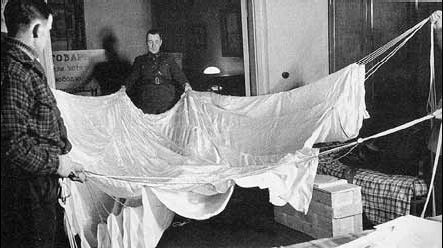
Lapin ryhmä saamaa sotasaalista.
Group Lappland´s war booty.
Picture from: http://www.sodatkuvina.cjb.net/
However, by mid-February, the Mannerheim Line was breached and by early March the weather improved. This caused the Finns to lose the natural advantage they had had during the colder part of winter. Thus, Mannerheim advised the Finnish government to sue for peace and on March 12th, the Russo-Finnish Treaty was signed in Moscow. The terms of this Treaty forced Finland to relinquish the Viipuri and Salli districts and a part of Sapmi with access to the Arctic Sea and also to lease Hanko as a military base. Although Finland lost the Winter War, the moral triumph of Finland was undiminished.
On January 27th, 1940, Hitler ordered detailed contingency planning of “Operation Weser,” the taking of Norway. Hitler’s decision to invade Norway was prompted by the USSR’s successful assault on Finland. This threatened to place Russia within striking distance of both the mineral resources of Sweden and the ports of Norway. Another event that prompted the German invasion was the interception of the Altmark by HMS Cossack, a British destroyer commanded by Captain Philip Vian. The German ship Altmark, that had been the supply ship to the Graf Spee, was carrying 299 British Merchant Navy prisoners back to Germany. On direct orders of Winston Churchill, Captain Vian informed the Norwegians that he was stopping the Altmark, boarded the prison ship in Jøssing Fjord and released the prisoners and returned them to Britain. This was a crucial event, which convinced Hitler that while Norway was powerless to act when either power breached international law in Norwegian waters, if it were occupied by the British and more specifically, the British Royal Navy, this would mean trouble for Germany.
Thus, the invasion of Norway was originally set for March 20th, but was postponed until April 9th, 1940. It is rumored that Vidkun Quisling (the Defense Minister of Norway and leader of the local Nazi party, the NS) had planned the invasion with the Germans. Quisling planned not only to help Germany invade Norway, but also to eradicate the Norwegian Sami because he considered them inferior to the Norwegian race (http://www.nuav.net/ns.html). About four days prior to the invasion, the Norwegian Government had been provided with advance warning of the attack from a friendly Dutch military attaché but did not act on the information.
The Allies’ reaction to the invasion was appallingly late. Three days after news of the invasion had been leaked to the Allies, Admiral Sir Charles Forbes headed for Norway, on the 7th, to provide cover for minelaying operations. The British Navy did exactly what the Germans had hoped it would do by instructing Admiral Forbes not to follow the German fleet into Trondheim but to intercept the Scharnhorst and the Gneisenau. These were operating as an independent battle squadron and acting as bait to keep the Royal Navy away from the German landings in Norway.
As a result, by the evening of April 9th, Germany was in control of the most important strategic positions in Norway and Denmark. The willingness of the Norwegian people and government to fight was evident but Norway’s organization was ineffective. General mobilization was announced only after the invasion had begun.
Germany seized the port of Narvik from which Germany then received a major part of its Swedish iron ore.
The Germans were isolated in Narvik by the Royal Navy on the 13th of April 1940. They did, however, have plenty of captured Norwegian weapons in addition to their own, and a “Mountain Marine” unit of 2,600 men, survivors of the annihilated destroyer fleet, to use the Norwegian rifles and machine guns. The “Mountain Marines” were ordered to “hold out for as long as possible.”
The “Mountain Marines” forced the Norwegian Sami they encountered to act as guides for them on the unfamiliar mountainous and snowy terrain. The Sami proved to be useful guides to the “Mountain Marines” because they very familiar with the area and were able to cover far distances on skis. With only military supplies, the “Mountain Marines” depended largely on Sami reindeer herds for food. Many of the Sami that the Germans forced to act as their guides had originally been employed by the Norwegian government as part of the ski cavalry (http://hem.fyristorg.com/robertm/norge /norway_reference.htm).
Allied forces were concentrated on Narvik because it was evident that the British plan to retake the center of Norway could not work, for on April 26th, the German 196th Division, on the right of the 21st Corps, succeeded in joining up with the 181st Division on the left, south of Trondheim.
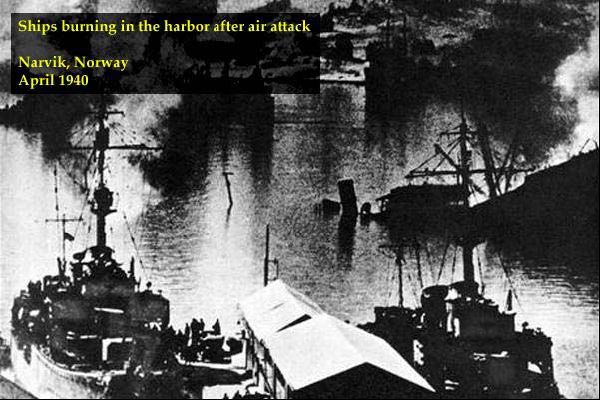
Picture from:
http://www.worldwar2database.com/EUROWAR/images/norway/viewer.htm
Narvik was important because its port was the vital route for iron resources. The Germans used forced labor to mine and deliver the iron ore. Much of this labor consisted of Sami who had been working the mines prior to WWII.
On April 26th, King Haakon and most of his government fled to Tromsø and the final phase of the Norwegian battle began. On May 28th, the French 13th Foreign Legion Demi-Brigade finally recaptured Narvik. However, soon Allied attention was focused on the events in the Low Countries of Europe and France. The Allies only stayed long enough to cover the evacuation of the Allied armies from Norway. Then, Norway and Denmark were completely left in German hands. It must be recalled that the Nazis considered the Norwegians to be an Aryan people; repressions in Norway, while often severe, could not compare to the treatment of Poles or Russians, who were viewed as sub-humans (http://www.geocities.com/CapitolHill/2808/norway.html). However, the Sami were considered “sub-humans”, and were treated as such, by the Germans because many of them were short with dark features instead of having the blond hair and blue eyes that the Germans considered superior.
On June 7th, 1940, Norwegian forces battled the German troops near the Swedish border. However, on June 9th, 1940, the Norwegian government ceased hostilities on Norwegian soil as a result of the allied defeat on the continent. Thus, German General Eduard Dietl recaptured Narvik.
Soon after the Germans had fully occupied Norway, they forced Sweden to allow the German armed forces to use Sweden’s railway system. The railway was to be used for transports, to and from Norway, of unarmed German soldiers on their way to and from leave. This agreement was reached on June 18th, 1940. However, only 8 days later, on June 26th, the Germans began sending troop transports through Sweden. This was in direct violation of many Swedish rules.
The Germans soon set up a base in Luleå in September 1940. As a result, a new railway was built to connect the base directly to the national railway system. Many Sami forced laborers were used to lay the rail and then later to load the trains which were sent to the German occupation troops in Norway. Shortly after the base was set up, SS Troops were transported from Luleå, by train, to Narvik and then to the Norwegian province of Finnmark.
Finnmark bordered the Finnish Petsamo area, next to Soviet Russia. From here, Operation Barbarossa was launched and the attack on the Soviet Union by Germany began On June 22, 1941. This was also known to the Finns and to the Finnish Sami as the “Continuation War.”
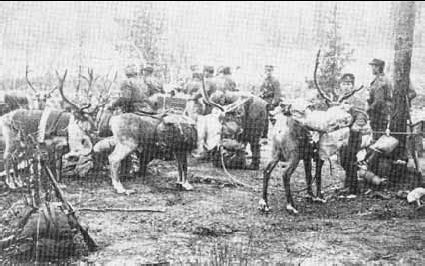
Lähellä Sallaa Pohjois-Suomessa suomalaisia sotilaita ja luotettavin
"kuljetusväline" pohjoisessa, porot. Syyskuu 1941.
Near Salla in Northern Finland Finnish soldiers and most reliable "transport
equipment" in north, reindeers. September 1941
Photo from: http://www.sodatkuvina.cjb.net/
The main reason that Finland attacked the Soviet Union with Germany is that Finland wanted back the areas that were lost in the Winter War. The Sami were especially committed to this endeavor because part of the areas Finland was trying to reclaim included part of Sapmi. During this time, the Sami were fighting Sami. The Finnish Sami came face to face with the Russian Sami on July 1st, 1941. The SS Division “Nord” and the 169th Infantry Division and the Finnish 6th Infantry Division attacked the South Kola.
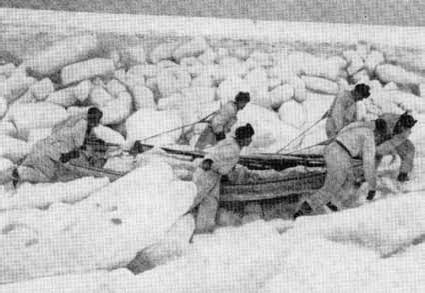
Suomalainen kaukopartio Suomenlahdella joulukuussa 1941.
Finnish long distance patrol in Gulf of Finland, December 1941
Photo from: http://www.sodatkuvina.cjb.net/
The Finnish Sami were fighting the Sami living in the Kola Peninsula on the Russian side. These two groups of Sami, were forced to fight each other, not because they wanted to, but because a border had been drawn between them long ago. So, in a sense, a “brother fighting brother” war was now taking place among the Sami people. Most of the Finnish Sami were members of the Long Distance Patrol because of their ability to cover several kilometers a day on skis and their ability to navigate unfamiliar terrain. The Russian Sami who weren’t fighting in the war were evacuated. Over 60,000 people were housed in temporary camps in Sweden. Only after the war did they return to their villages (http://www.uoc.es/euromosaic/web/document/sami/an/i1/i1.html). Several Sami, however, were not evacuated and many of them ended up in German prison camps.
Life for the Sami in the German prison camps was almost unbearable. Not only were they treated brutally by the Germans but they were also looked at as “outsiders” by their fellow inmates. This is because many of them only spoke Sami dialects and thus could not understand or be understood by not only their captors but also their fellow inmates. It must have been a terrifying experience to say the least.
The war started to turn against the Germans and the Finns when, on September 22, 1941, they were stopped on the western bank of the Litsa River. Then, in the months from January to March of 1942, much-needed arctic tents and barracks were delivered from Sweden to the freezing German and Finnish troops who were attacking the Kola Peninsula. They were running short of supplies and ammunition during these wintery months of unsuccessful fighting (http://www.mil.fi/joukot/satlsto/sisalto/history7.htm).
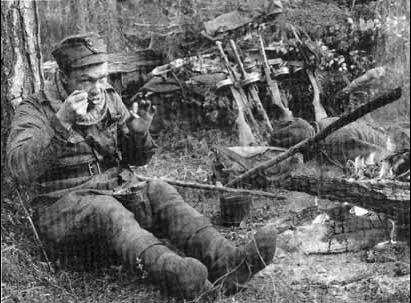
Kaukopartion jäsen ruokailee jossain vihollislinjojen takana syyskuussa 1942.
Member of Long distance patrol eating somewhere behind enemy lines
September 1942. Photo from: http://www.sodatkuvina.cjb.net/
*(This could possibly be a Sami because many Sami were members of the Long distance
patrol of Finland during the Continuation War)
From April to August of 1942, the Soviets were under constant attack from the Germans and Finns. Finally, they decided to attack Finland in the hopes that Finland would withdraw it’s support from Germany.
On June 9th, 1944, two Soviet armies attacked the southern Finnish border town of Viborg and threatened Helsinki. Also, on June 20th, 1944, two more Soviet armies launched an attack against the heartland of Finland from the Onega area. This resulted in the Soviet-Finnish Armistice. This was signed on September 4th, 1944. It meant not only great territorial loss for Finland, such as Salla and Karelia, but also required the Finnish army to drive out all the German forces from Finland. As a result of the Continuation War, the North was devastated and Rovaneimi, the capital of Finnish Sapmi was left in ruins (http://www.bradmans.com/scripts/display.cgi?type=hgc&city=211).
On September 15th, 1944, the “Lappland War” began. Because one of the agreements for the Soviet-Finnish Armistice was that Finland had to drive out all German forces from Finland, Finnish troops invaded the coastal towns that were still under Germany’s rule. These Finnish troops were mostly Sami because this area that they were trying to drive the Germans out of was their home, Sapmi. The Germans wanted to leave Finland with all of their equipment but to do so would have taken longer than the Soviet- Finnish Armistice allowed, thus the Finnish Sami troops had to invade the areas still occupied by the Germans to force them out. This was a delicate task the Sami had to balance. This is because on the one hand, invading German occupied areas and trying to drive them out could cause the Germans to destroy everything. On the other hand, not driving the Germans out in the amount of time allowed by the Soviet-Finnish Armistice could cause the Soviets to break their agreement with the Finns and lead to another war with the Soviets. The last thing that the Sami or the Finns wanted was another war with the Russians.
The Soviets used the terms that they wanted a more “active Lappland” to fight and resist the Germans. Well, the reason that Sapmi had not been as active as other areas of Finland to force the Germans to leave is that it is not in the nature of the Sami to be hostile. When one looks at Sami history, they have interacted with “outsiders” in nonhostile, friendly ways for hundreds of years. The Sami are not a war-like people; nor were their ancestors. Also, the Sami were used to harsh treatment from the Finns already because that sort of discrimination had been going on for hundreds of years. Thus, when the Germans came in and occupied parts of Sapmi in Finland they treated the Sami badly. However, this treatment was reported in several cases not to be usually any worse than the treatment the Sami received from the Finns.
However, when the Finnish Sami troops invaded the German occupied areas of Finland to force them out, the Germans became very angered. The Germans were completely taken by surprise when the invasions occurred and sought revenge.
To avenge this declaration of war by the Finnish Sami troops, the Germans used the tactic of scorched earth. They burned almost every building in Sapmi except for a few buildings that were located in outlying districts. They also laid mines which were used to slow down the advance of the Finnish Sami troops (http://www.sodatkuvina.cjb.net/). On October 7th, 1944, Hitler approved Operation Nordlicht, which called for the retreat from Kola and Finnish Sapmi to the Lyngen position in Norway. This was just north of the top of Sweden.
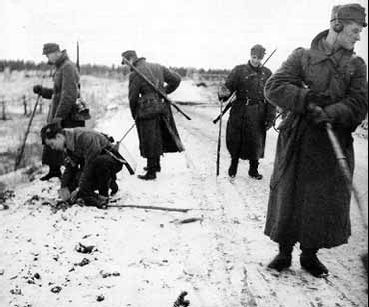
Suomalaiset raivaavat tietä miinoista.
Finnish searching mines
Photo from: http://www.sodatkuvina.cjb.net/
Colonel-General Rendulic attempted to retain the base at Petsamo and the nickel mines at Kolosjoki for Germany, but was attacked on October 7th by the Russian Karelian Front under General Meretskov. And, by October 15th, the Russians had captured Petsamo from the Germans and had also marched into Norway and captured German occupied Lyngenfjord. Because of all this, Finland lost it’s only access to the Atlantic due to the capture of Petsamo by the Russians and it lost the valuable nickel mines in the region.
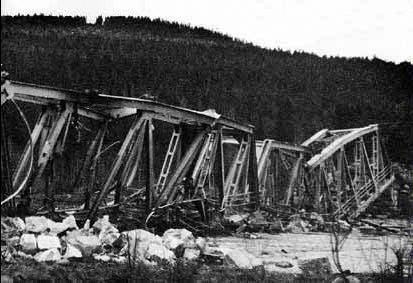
Saksalaiset räjäyttivät Aavasaksan yhdistetyn maantie- ja rautatiesillan .
Germans blew up Aavasaksa´s combinated mainroad and railway bridge.
Photo from: http://www.sodatkuvina.cjb.net/
Not only did Finland lose its access to the Atlanic but the tactic of scorched earth resulted in the destruction of several Sami structures such as frames for lavvus that had been preserved for hundreds of years. Sapmi was virtually destroyed and left in utter ruin. Not only did the Germans burn the towns but they also burned the forests. Without the forest areas, and having much of the land scorched and burned, reindeer herding was severely affected. So, not only did the Sami lose their homes but also their way of living and making a living and of keeping their families fed. The last of the German troops went from Norway on April 23, 1945 and the “Lappland War” was declared at an end few days later on April 25th, 1945.
However, during the “Lappland War,” on September 23, 1944, 23,400 Finns and Sami were evacuated from Finnish Sapmi to north Sweden. This massive refugee operation was undertaken by the Swedish Army and the Swedish Red Cross. Many Sami were relocated during this time and many of them never returned to their original homes even after the war had ended.
The Russians had marched to Norway, chasing the Germans from Finland. On October 25, 1944, the Soviets liberated Kirkenes and immediately began to support the Norwegian population. Most of the Norwegian population had remained in hiding which was a violation of German orders.
The German troops had used the Norwegians and the Norwegian Sami as forced labor during the occupation and had committed numerous atrocities against the people. There are several accounts of German troops raping Norwegian and Sami women. As a result of this kind of brutality many of the women became sterile from repeated rapes and several committed suicide. The Sami men and women and children were treated and considered to be less than human by the German troops and were treated as such under German occupation in Norway.
When the Russians liberated parts of Norway, no rapes or other atrocities were reported to have been committed by the Soviet Army. Thus, the attitudes between the liberating Russians and the liberated Norwegians are friendly attitudes.
On October 29th, 1944, British Lancaster bombers successfully attacked and sank the German battleship, Tirpitz, near Tromsø and 1200 German sailors died with the ship.
Then, on December 30th, 1944, ten USAAF C-47 Dakotas, under the command of Colonel Bernt Balchen, took part in the aftermath of the Petsamo and Kirkenes operation by transporting 1,442 Norwegian ski troops to North Norway. These ski troops consisted mostly of Swedish Sami who had been trained in neutral Sweden as police troops before the war. The USAAF also transported military, medical and civilian supplies to Kirkenes and other parts of Norway.
This USAAF unit was under the direction of the Office of Strategic Services (OSS), which was the precursor to the CIA and the Milorg, the Norwegian resistance group. This mission went on from December 29th, 1944 to August 1, 1945. “Operation Where and When”, as it was called, used the ski troops that were brought to Kirkenes to support the Red Army units in Arctic Norway to drive out the German forces. At the same time, this made it very clear to the Soviets that Finnmark, which is the easternmost Norwegian county and home to many Sami, was a part of Norway. These Swedish Sami ski troops were used by the Russians in Norway mostly as guides because of their excellent ability to navigate through harsh conditions in the snow and mountainous areas of Norway.
Then, on March 4, 1945, Finland officially declared war on Germany even though they had been fighting German troops since September of 1944. The last Finnish-German battle took place on April 27, 1945. The German 20th Mountain Army and the Finnish Army fought near Kilpisjarvi. Kilpisjarvi was located in the far northwestern corner of Finnish Sapmi. Much of Kilpisjarvi was already destroyed prior to this battle and even though the Finnish Army won the battle, there was still much work ahead because of all the damage the Germans had left in their wake.
On May 7th, 1945, Victory in Europe (VE-Day) was celebrated. An American, Norwegian, and Swedish part was held in Luleå.
However, on June 7th, 1945, several Soviet POWs in Narvik and Bodø areas were in horrible shape. They had been forced to build Hitler’s arctic railway and were treated almost as badly as victims in the German concentration camps. Many of these Soviet POWs were Sami from the Kola Peninsula. The Swedish Red Cross came to their aid with help from the USAAF.
On September 25th, 1945, the Soviets unexpectedly left Kirkenes after a very brief ceremony with the local Norwegians. It had been feared that the Soviets would want to stay in Norway and occupy it for a while but that fear was diminished when the Russians unexpectedly left that day.
Now the process of rebuilding took place in Sapmi in Norway, Sweden, Finland, and Russia. Almost all of Sapmi was affected and devastated by this war. The Sami themselves were forced to play integral roles in the campaign against the German and Russian invasions of their home, Sapmi.
Prior to this war, the Sami had lived in peace with each other. For hundreds and thousands of years, they had lived as peaceful peoples and were not warrior-like peoples. They had treated all newcomers and invaders of Sapmi with tolerance instead of aggression. This war forced them to go against their normal instincts and fight in an aggressive war that threatened to destroy the very heart of their cultural existence. The Sami soldiers were very important to efforts in this war. Without them, who knows how the tides could have changed? They were indispensable and important guides and soldiers and long distance patrolmen. They knew how to survive harsh temperatures of extreme cold. In the fight of the Germans and Finns against the Russians, it was the Germans who suffered more from the cold temperatures than the Finnish Sami. They knew how to survive these temperatures because their ancestors had passed down this knowledge to them from generations of Sami going back thousands of years. They knew how to harness and tame the reindeer that were needed to transport supplies where tanks and trains and railroads and convoys could not go because of the deep snow and harsh weather conditions. They were masters on the skis and could cover long distances. Their language contains hundreds of words describing snow and weather conditions and reindeer. Thus, the Sami soldiers who still spoke the Sami languages were able to communicate effectively and efficiently with each other about traveling conditions over several kilometers of frozen tundra during the war.
This war not only destroyed much of Sapmi but it also destroyed much of their heritage. The Germans scorched land tactics burned most of the remnants left by the ancestors of the Sami hundreds of years ago which had been still standing after all that time. Had things turned out differently the Sami people might not even be here today. If the Germans had won the war, they had planned to start systematically “exterminating” the Sami because they considered them less than human and compared them to the Jewish people whom they hated so much.
In this war, Sami fought Sami because they were forced to fight on the side of whichever border their part of Sapmi was located on. This was something that normally only Tchudes would have done but because of this war, the Sami were forced to fight and not just to fight but also to fight other Sami.
Rovaniemi, the capital of Finnish Sapmi, lay in ruins after the war because the Germans burned it to the ground. Now, when one visits Rovaniemi it does not even resemble what it looked like before the war. It is a totally different city. However, the Sami did preserve its Læstadian quality, in the architecture of its buildings and streets is very Spartan, even though a lot of Sapmi had to be rebuilt after the war. There were many Sami who never returned to their villages after relocation during the war. Most of the Kola Peninsula Sami were relocated to Inari villages and never returned to the Kola Peninsula after the war.
This war did have many devastating effects and consequences that affected the Sami, but they still found a way to persevere. They were able to preserve much of their cultural heritage and it is still very much alive today. The Sami are survivors. They have survived thousands of years of invasion and intrusion from agriculturalists and they survived arguments over borders and forced assimilations. They have survived Christianity and its harsh toll on the Sami way of life. So it is no wonder that they were able to survive even the harsh and devastating effects of World War II.
Sources
Internet resources:
- http://www.nuav.net/ns.html
- http://hem.fyristorg.com/robertm/norge /norway_reference.htm
- http://www.worldwar2database.com/EUROWAR/images/norway/viewer.htm
- http://www.geocities.com/CapitolHill/2808/norway.html.
- http://www.sodatkuvina.cjb.net/
- http://www.uoc.es/euromosaic/web/document/sami/an/i1/i1.html
- http://www.mil.fi/joukot/satlsto/sisalto/history7.htm
- http://www.bradmans.com/scripts/display.cgi?type=hgc&city=211
Book resources:
Keegan, John. World War II, Day by Day. DK Publishing, Chicago, 2001: 45-60 and 478-509.
